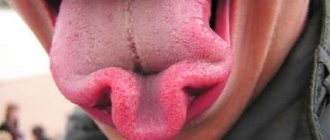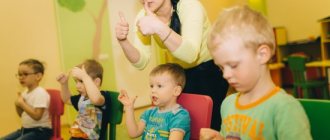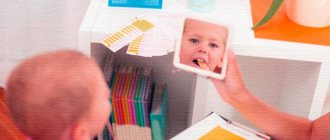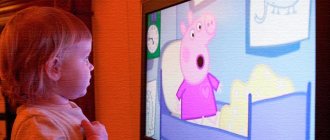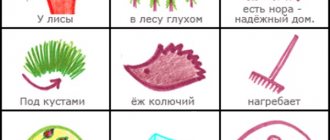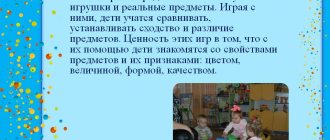Dysarthric speech disorders in children of early and preschool age
Dysarthria (speech motor disorder) is a violation of the pronunciation aspect of speech caused by insufficient innervation of the speech muscles. Dysarthria is a consequence of organic damage to the central nervous system, in which the motor mechanism of speech is disrupted. With dysarthria, it is not the programming of speech utterance that is impaired, but the motor implementation of speech. The leading defects in dysarthria are disturbances in the sound-pronunciation aspect of speech and prosody, as well as disturbances in speech breathing, voice and articulatory motor skills.
Speech intelligibility in dysarthria is impaired, speech is blurred and unclear. Main disorders (structure of the defect) in dysarthria
Impaired tone of articulatory muscles (facial muscles, tongue, lips, soft palate) such as spasticity, hypotension or dystonia. 1. Spasticity - increased tone in the muscles of the tongue, lips, face and neck. With spasticity, the muscles are tense. The tongue is pulled back “lumpy”, its back is spastically curved, raised upward, the tip of the tongue is not pronounced. The tense back of the tongue raised towards the hard palate helps soften consonant sounds (palatalization). Sometimes the spastic tongue is pulled forward with a “sting.” An increase in muscle tone in the orbicularis oris muscle leads to spastic tension of the lips, tightly closing the mouth (voluntarily opening the mouth is difficult). In some cases, with a spastic condition of the upper lip, the mouth may, on the contrary, be slightly open. In this case, increased salivation (hypersalivation) is usually observed. Active movements with spasticity of the articulatory muscles are limited. (Muscle spasticity is noted with spastic-paretic dysarthria.) 2. Hypotonia - decreased muscle tone. With hypotonia, the tongue is thin, spread out in the oral cavity; lips are flaccid and cannot close tightly. Because of this, the mouth is usually half-open, and hypersalivation may be expressed. Hypotonia of the muscles of the soft palate prevents the velum from moving sufficiently upward and pressing it against the back wall of the pharynx; a stream of air exits through the nose. In this case, the voice acquires a nasal tint (nasalization). (Hypotonia of articulatory muscles occurs with spastic-paretic and ataxic dysarthria.) 3. Dystonia is a changing nature of muscle tone. At rest, low muscle tone may be noted; when attempting to speak and at the moment of speech, the tone increases sharply. Dystonia significantly distorts articulation. A characteristic feature of sound pronunciation in dystonia is the inconstancy of distortions, substitutions and omissions of sounds. (Dystonia is noted with hyperkinetic dysarthria.)
In children with neurological pathology, a mixed and variable nature of tone disturbances in the articulatory muscles (as well as in the skeletal muscles) is often noted, i.e. in individual articulatory muscles, tone can change differently. For example, spasticity may be observed in the lingual muscles, and hypotonia in the facial and labial muscles. In all cases, there is a certain correspondence between tone disturbances in the articulatory and skeletal muscles. Impaired mobility of articulatory muscles. Limited mobility of the muscles of the articulatory apparatus is the main manifestation of paresis of these muscles.
Insufficient mobility of the articulatory muscles of the tongue and lips causes disturbances in sound pronunciation. When the lip muscles are damaged, the pronunciation of both vowels and consonants suffers. Articulation in general is impaired. Sound pronunciation is especially severely impaired when the mobility of the tongue muscles is sharply limited. The degree of impairment of the mobility of articulatory muscles can be different - from complete impossibility to a slight decrease in the volume and amplitude of articulatory movements of the tongue and lips. In this case, the most subtle and differentiated movements are disrupted first (primarily raising the tongue upward).
Specific violations of sound pronunciation : - persistent nature of violations of sound pronunciation, particular difficulty in overcoming them; - specific difficulties in automating sounds (the automation process requires more time than with dyslalia). If speech therapy classes are not completed on time, acquired speech skills often disintegrate; - the pronunciation of not only consonants, but also vowels is impaired (average or reduced vowels); - the predominance of interdental and lateral pronunciation of whistling [s], [z], [ts] and hissing [sh], [zh], [h], [sch] sounds; - deafening of voiced consonants (voiced sounds are pronounced with insufficient participation of the voice; - softening of hard consonant sounds (palatalization); - disturbances in sound pronunciation are especially pronounced in the speech stream. With an increase in speech load, general blurriness of speech is observed and sometimes increases.
Depending on the type of violation, all sound pronunciation defects in dysarthria are divided into two categories: anthropophonic (sound distortions) and phonological (substitutions, confusions). In dysarthric disorder, the most typical violation of the sound structure of speech is sound distortion.
Speech breathing disorders . Breathing disorders in children with dysarthria are caused by insufficient central regulation of breathing. Insufficient depth of breathing. The rhythm of breathing is disturbed: at the moment of speech it becomes more frequent. There is a violation of the coordination of inhalation and exhalation (shallow inhalation and shortened weak exhalation). Exhalation often occurs through the nose, despite the half-open mouth. Respiratory disorders are especially pronounced in the hyperkinetic form of dysarthria.
Voice disorders . Voice disorders are caused by changes in muscle tone and limited mobility of the muscles of the larynx, soft palate, vocal folds, tongue and lips. The most common symptoms are insufficient voice strength (quiet, weak, fading) and deviations in voice timbre (dull, nasal, constricted, hoarse, intermittent, tense, guttural).
In various forms of dysarthria, voice disturbances are of a specific nature. Violations of prosody (melodic-intonation and tempo-rhythmic characteristics of speech). Melody-intonation disorders are often considered one of the most persistent signs of dysarthria. They greatly influence the intelligibility and emotional expressiveness of speech. There is a weak expression or absence of vocal modulations (the child cannot voluntarily change the pitch). The voice becomes monotonous, poorly or unmodulated.
Violations of speech tempo are manifested in its slowing down, less often - in acceleration. Sometimes there are disturbances in the rhythm of speech (for example, chant - “chopped” speech, when there is an additional number of stresses in words).
Lack of kinesthetic sensations in the articulatory apparatus. In children with dysarthria, there is not only a limitation in the range of articulatory movements, but also a weakness in the kinesthetic sensations of articulatory postures and movements.
Autonomic disorders. One of the most common autonomic disorders in dysarthria is hypersalivation. Increased salivation is associated with limited movements of the tongue muscles, impaired voluntary swallowing, and paresis of the labial muscles. It is often aggravated due to the weakness of kinesthetic sensations in the articulatory apparatus (the child does not feel the flow of saliva) and decreased self-control.
Hypersalivation can be expressed to varying degrees. It can be constant or intensify under certain conditions. Even mild hypersalivation (moistening of the corners of the lips during speech, slight leakage of saliva) indicates the presence of neurological symptoms in the child. Less common are vegetative disorders such as redness or pallor of the skin, increased sweating during speech.
Violation of the act of receiving food. Children with dysarthria often have difficulty, and in severe cases, no chewing of solid food or biting off a piece. Choking and choking when swallowing are often observed. Difficulty drinking from a cup. Sometimes coordination between breathing and swallowing is impaired.
The presence of synkinesis. Synkinesias are involuntary accompanying movements when performing voluntary articulatory movements (for example, additional upward movement of the lower jaw and lower lip when trying to raise the tip of the tongue). Oral synkinesis - opening of the mouth during any voluntary movement or when attempting to perform it. Increased pharyngeal (gag) reflex. Loss of coordination of movements (ataxia).
Ataxia manifests itself in dysmetric, asynergic disorders and in the scantiness of the rhythm of speech. Dysmetria is a disproportion, inaccuracy of voluntary articulatory movements. It is most often expressed in the form of hypermetry, when the desired movement is realized in a more sweeping, exaggerated, slower movement than necessary (excessive increase in motor amplitude). Sometimes there is a lack of coordination between breathing, voice production and articulation (asynergia). Ataxia is noted with ataxic dysarthria.
The presence of violent movements (hyperkinesis and tremor) in the articulatory muscles. Hyperkinesis - involuntary, irregular, violent; There may be pretentious movements of the muscles of the tongue and face (hyperkinetic dysarthria). Tremor - trembling of the tip of the tongue (most pronounced during targeted movements). Tremor of the tongue is observed with ataxic dysarthria.
From the book Prikhodko O. G. “Speech therapy massage for the correction of dysarthric speech disorders in children of early and preschool age.
Advice from a speech therapist: “Strengthening the muscles of the speech apparatus”
Novozhilova Galina Aleksandrovna
Advice from a speech therapist: “Strengthening the muscles of the speech apparatus”
Incorrect pronunciation brings a child a lot of grief and difficulties in kindergarten, and at school these difficulties increase. Deficiencies in oral language often affect written language. The child does not cope well with the sound analysis of words, often uses another instead of one letter, and writes as he speaks. Clear pronunciation, lexical richness, grammatically correct and logically coherent speech are the merit, first of all, of family upbringing. And, on the contrary, insufficient attention to the child’s speech often becomes the main cause of pronunciation defects, failure to pronounce or distortion of sounds. We will help your child eliminate these violations, form and consolidate the correct articulation of sounds. And yet, you must take on the main burden of teaching your child to speak correctly! What will be required of you, loving parents, is close cooperation with teachers, patience, and the ability to interest your child and include him in the work process. If all conditions are fulfilled in good faith , then the classes will soon give the best results. Under no circumstances should you imitate a child’s incorrect pronunciation - “lisp”
with him.
Thus, you deprive the child of the opportunity to hear the correct pronunciation and distinguish it from the incorrect one. This leads to the fact that the child does not develop auditory self-control and distorted pronunciation is reinforced. You should always speak correctly with children and thus give the child a speech role model. Why do children have difficulty with some sounds? Firstly, their phonemic hearing is not yet sufficiently developed, so they often do not recognize sounds in an adult’s and reproduce them in a distorted form. Secondly, the child’s articulatory apparatus is still very unstable, and it is not easy for him to cope with obstacles in the path of the air stream when he pronounces consonant sounds. In order for the desired sound to be formed, the tongue, lips and teeth must take a certain position, and this is precisely what a child sometimes fails to do. The tongue, lips, lower jaw, and soft palate take part in the formation of sounds. Thus, when different sounds are formed, each organ occupies a certain position. In speech, sounds are not pronounced separately from each other, but one after another, so the organs of the articulatory apparatus must quickly change their position. Clear pronunciation of sounds, words, phrases can be achieved if all the organs involved in the formation of sounds are sufficiently mobile and their work is coordinated. Articulation gymnastics will help with this. Rules for performing articulatory gymnastics Articulation exercises help strengthen the muscles of the speech apparatus , form correct, full-fledged movements of the articulatory organs (tongue, lips, lower jaw, etc., improve diction; therefore, articulatory gymnastics is necessary for children with speech disorders , and is useful for all children, both with both for the purpose of preventing disorders and for the purpose of developing speech. It is recommended to carry out articulatory gymnastics systematically so that the developed skills are consolidated. It is better to practice every day 2 times a day for 5–10 minutes. At first, it is good to perform the exercises in front of a mirror, where the child will see both himself and you. In the future, it will be possible to do without a mirror. But do not forget that the child masters speech skills by imitating adults. Therefore, more often show the child how to do this or that movement, teach him to look at the adult and imitate him . The number of repetitions of articulation exercises varies depending on the age and motor abilities of the child and on average ranges from 3 to 5 repetitions. The static load can also increase as the child's motor capabilities increase. If at the beginning you can limit holding the articulatory position to a count of 2, then over time, as the muscles , the count increases to 5-10. Any exercise must be approached individually; you should not force events by trying to master a difficult exercise in a short time . It is better to carry out articulatory gymnastics in a playful way, imitating, competing or imitating someone. For example, by achieving a clear and correct position in the “Fence”
, it is easier for a child to master lip movements and keep them in the desired position if he portrays a frog with his mouth reaching to his ears. You can ask the child:
“Make a smile from ear to ear, even if you sew on the strings !”
. Flexibility of tongue movements and rapid vibration of the tip of the tongue are an important prerequisite for producing the r sound. For this purpose, you can play a game of horses and coachmen with your child. Coachmen click their tongues, horses clatter their hooves - both help develop the flexibility of the tongue and are interesting to the child. This formulation of the task creates a cheerful mood in the child and constructively facilitates the process of completing the exercise. To maintain interest in doing the exercises, you can use various poetic accompaniments for each type of exercise. Exercises to produce a strong stream of air, necessary for pronouncing hissing and whistling sounds, are very useful. For this purpose, you can invite the child to blow strongly on cotton balls, dandelions, light objects located in a basin of water (ships, fish, compare who blew better, whose boat sailed further. It is also useful to blow soap bubbles. But when doing breathing exercises Be careful and careful, as they can cause dizziness. It will be enough to perform them 5 times. Regular performance of articulatory gymnastics helps to develop correct, full-fledged movements of the articulatory organs necessary for the correct pronunciation of sounds.
